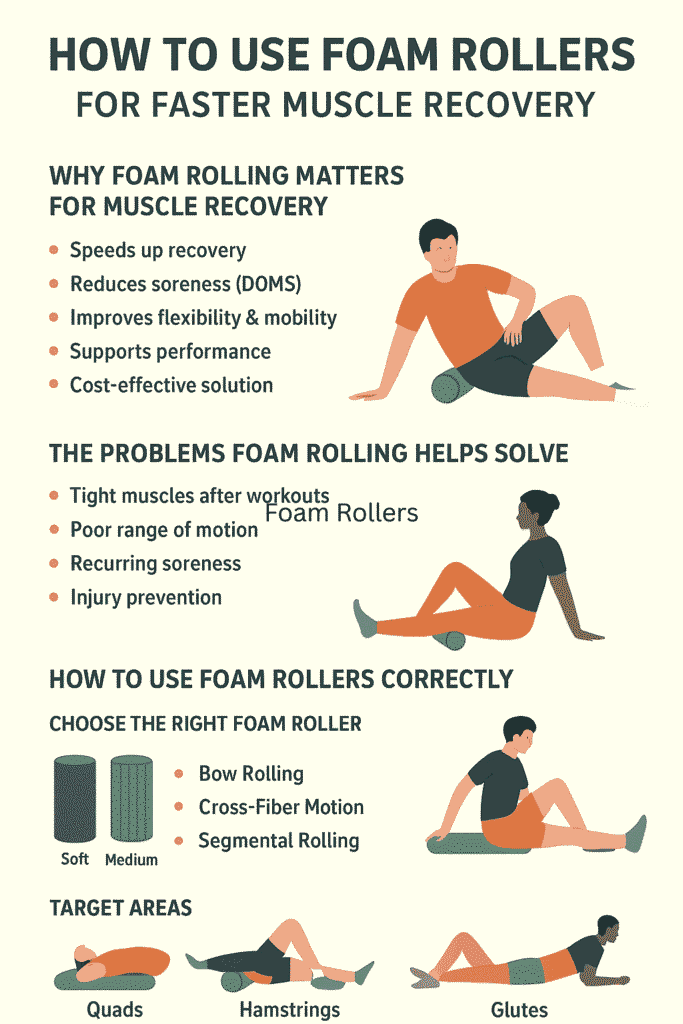Table of Contents
Foam Rollers for Faster Muscle Recovery
Muscle soreness after intense workouts is a universal experience for athletes, fitness enthusiasts, and even beginners starting their fitness journey. That stiff, achy feeling—technically called Delayed Onset Muscle Soreness (DOMS)—can slow down progress, reduce performance, and sometimes even lead to injuries if ignored. While rest, hydration, and nutrition play a major role in recovery, one simple, affordable, and science-backed tool can speed up the process: the foam roller. Foam rolling, also known as self-myofascial release, helps release muscle tension, break down tight knots, and improve blood circulation. But to truly maximize its benefits, athletes need to understand not just how to use it, but also why it works, when to use it, and which techniques suit different types of pain or soreness.
Why Foam Rolling Matters for Muscle Recovery
- Speeds up recovery: Increases blood flow to muscles, delivering oxygen and nutrients needed for repair.
- Reduces soreness (DOMS): Helps clear lactic acid buildup after intense training.
- Improves flexibility & mobility: Keeps muscles from stiffening, reducing risk of injury.
- Supports performance: A body free of tightness responds better to strength training, endurance work, and agility drills.
- Cost-effective solution: Unlike professional massages, foam rollers are a one-time investment for long-term benefits.
The Problems Foam Rolling Helps Solve
Tight Muscles After Workouts – Heavy squats or long runs often leave quads, hamstrings, and calves feeling stiff. Foam rolling helps release that tightness, restoring normal muscle length.
Poor Range of Motion – Athletes who feel restricted during lifts or sprints may actually be dealing with muscle adhesions or knots. Rolling helps break these down.
Recurring Soreness – If soreness lingers for days, it can delay training schedules. Foam rolling accelerates healing, allowing athletes to return to workouts faster.
Injury Prevention – Tight, overworked muscles are more prone to strains or tears. By keeping tissues supple, foam rolling reduces these risks.
How to Use Foam Rollers Correctly

1. Choose the Right Foam Roller
- Soft rollers – Best for beginners or sensitive muscles.
- Medium density rollers – A balanced option for everyday recovery.
- Firm/textured rollers – Apply deeper pressure, suitable for experienced athletes or those with dense muscle tissue.
2. Key Techniques
- Slow Rolling: Move gently over the muscle, pausing on sore spots for 20–30 seconds.
- Cross-Fiber Motion: Roll slightly side-to-side over knots for deeper release.
- Segmental Rolling: Focus on one muscle group at a time instead of rushing through the whole body.
3. Target Areas
- Quads: Lie face down, roller under thighs, move slowly up and down.
- Hamstrings: Sit with roller under thighs, hands behind for support, roll from glutes to knees.
- Calves: Place roller under calves, lift hips slightly, and roll slowly.
- Glutes: Sit on roller, cross one ankle over the other knee, and tilt toward the working side.
- Upper Back: Lie back on roller, support neck, and roll gently between shoulder blades.
When to Foam Roll
- Pre-Workout: Increases blood flow and prepares muscles for high performance.
- Post-Workout: Reduces soreness and stiffness, speeds up muscle recovery.
- Rest Days: Keeps tissues healthy and promotes long-term flexibility.
Common Mistakes to Avoid
- Rolling too fast: Quick movements don’t allow tissues to relax.
- Spending too long on one spot: Overdoing it can bruise muscles or cause irritation.
- Ignoring posture: Keep core engaged to avoid unnecessary pressure on the spine.
- Rolling directly on joints or bones: Always stick to muscle areas.
Foam Rolling vs. Massage Guns: Which is Better?
Both tools aim to achieve similar goals but work differently. Foam rollers provide broader muscle release, great for large groups like quads, hamstrings, and glutes. Massage guns offer pinpoint relief, ideal for targeting knots, trigger points, or deep tissues. Many athletes combine both, starting with foam rolling for warm-up and using massage guns for specific recovery needs afterward.
Product Spotlight: Top 5 Massage Guns for Athletes in 2025
- TheraGun PRO 5th Gen – Professional-grade, multiple attachments, strong deep-tissue effect.
- Hypervolt Go 3 – Travel-friendly, ultra-quiet, lightweight.
- AchedAway Pro – Heavy-duty motor, great for strength athletes.
- Ekrin B37 – Ergonomic, balanced design for longer sessions.
- LifePro Sonic LX – Affordable yet powerful, with adjustable intensity.
If you’re looking for faster recovery, pairing a foam roller with a massage gun offers the best of both worlds.
FAQ: Foam Rolling and Recovery
Q1: How often should I foam roll? Most athletes benefit from 10–15 minutes, 3–4 times per week. On heavy training days, rolling after workouts is highly recommended.
Q2: Can foam rolling replace stretching? Not entirely. Foam rolling releases tightness, while stretching improves flexibility. The best recovery plans include both.
Q3: Does foam rolling hurt? Mild discomfort is normal, but it shouldn’t feel like sharp pain. If it does, reduce pressure or switch to a softer roller.
Q4: Can beginners use foam rollers? Yes. Start with soft rollers and short sessions, gradually increasing time and pressure as your body adapts.
Q5: Is foam rolling safe for everyone? Most athletes benefit, but those with serious injuries, fractures, or medical conditions should consult a physiotherapist before using.
Foam rolling is more than a trend—it’s a proven method to recover faster, move better, and train consistently without being sidelined by muscle soreness. Whether you’re a runner battling tight calves, a weightlifter nursing sore quads, or a casual gym-goer wanting better mobility, adding foam rolling to your routine is one of the simplest ways to protect your body and boost performance. Combine it with proper hydration, balanced nutrition, rest, and (optionally) massage guns for a complete recovery system.
